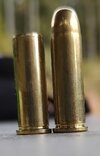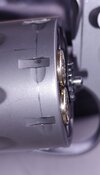I'd like a revolver Guru's opinion(s) on something. The rest of you can chime in, too! 
Is there an ammuntion-related event that would cause an otherwise reliable revolver to hang up on hammer cock & cylinder rotation?
I ruled out recoil bounce - cases sliding out & hanging up on the hand/star, etc. Further, I saw no evidence of loosened projectiles protruding from the front of the cylinder.
The problem felt like it was somewhere in the cylinder advance or hammer travel (backward) department, always in double-action mode and the majority of times in single action. The cylinder stop appeared to want to drop at the appropriate time. Lockup and timing were fine when the gun operated normaly.
The problem occurred on each cylinder-full of live rounds, and persisted when completely unloaded. Yet the following day, the revolver operated perfectly. (EDIT: when dry fired) I marked the offending chamber (Sharpie) and it was consistent to that chamber for the duration of the session (24 rds total, plus a lot of dry fire cycling).
Factory ammo, well within the capacity of the revolver (assuming it was loaded properly). Fired rounds felt consistent and recoil was unremarkable. No sign of overpressure on spent cases.
I am deliberately omitting the brand, model & caliber; I'm looking for a known- or theoretical situation. But lemme know if there is a documented issue for Revolver X in serial # range umptyseven through gigumptythirty.
Physical damage from one overpressure round should not have disappeared the following day... right? Temperature related?
I R baffled. Hep.
Is there an ammuntion-related event that would cause an otherwise reliable revolver to hang up on hammer cock & cylinder rotation?
I ruled out recoil bounce - cases sliding out & hanging up on the hand/star, etc. Further, I saw no evidence of loosened projectiles protruding from the front of the cylinder.
The problem felt like it was somewhere in the cylinder advance or hammer travel (backward) department, always in double-action mode and the majority of times in single action. The cylinder stop appeared to want to drop at the appropriate time. Lockup and timing were fine when the gun operated normaly.
The problem occurred on each cylinder-full of live rounds, and persisted when completely unloaded. Yet the following day, the revolver operated perfectly. (EDIT: when dry fired) I marked the offending chamber (Sharpie) and it was consistent to that chamber for the duration of the session (24 rds total, plus a lot of dry fire cycling).
Factory ammo, well within the capacity of the revolver (assuming it was loaded properly). Fired rounds felt consistent and recoil was unremarkable. No sign of overpressure on spent cases.
I am deliberately omitting the brand, model & caliber; I'm looking for a known- or theoretical situation. But lemme know if there is a documented issue for Revolver X in serial # range umptyseven through gigumptythirty.
Physical damage from one overpressure round should not have disappeared the following day... right? Temperature related?
I R baffled. Hep.
Last edited:




